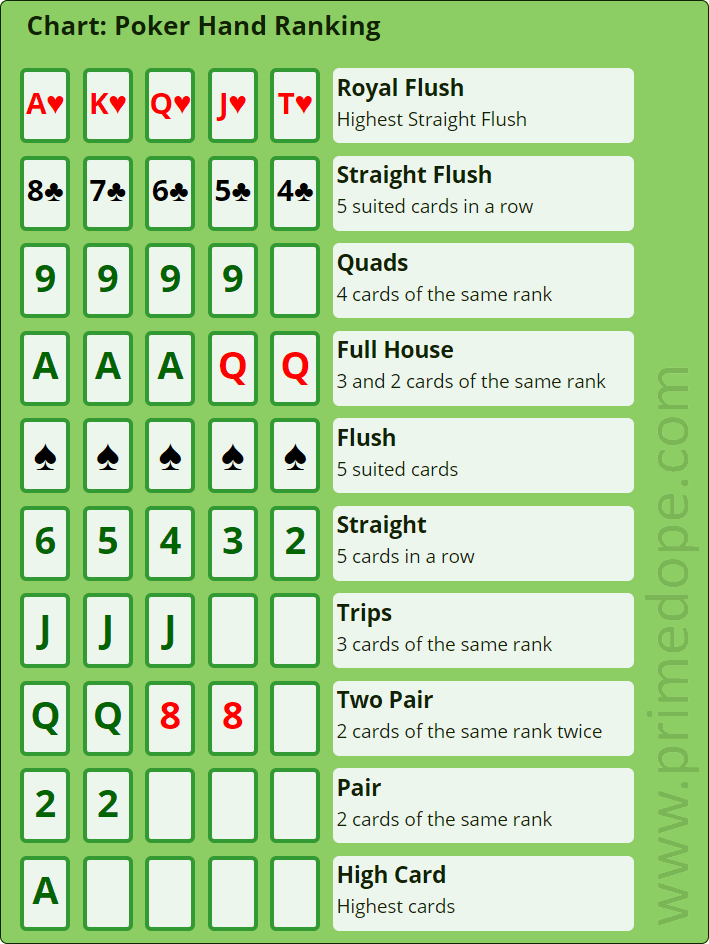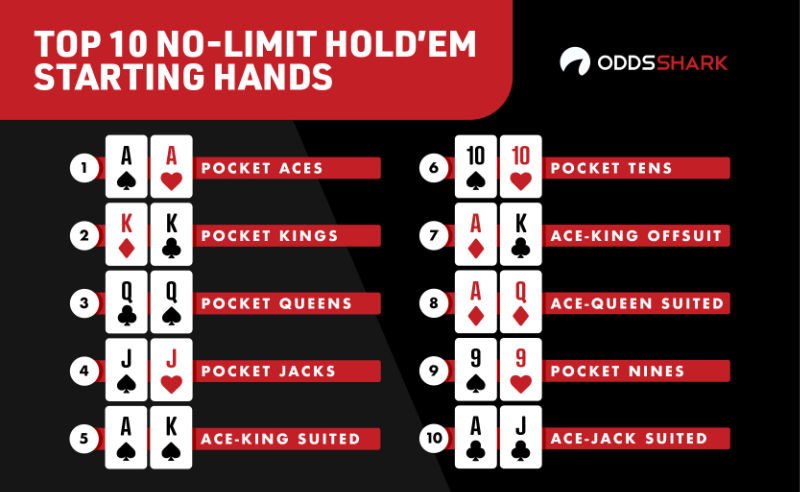Top Starting Hands In Texas Holdem 5,0/5 3892 votes
- Top 5 Starting Hands In Texas Holdem
- Top Ten Starting Hands In Texas Holdem
- Top 15 Starting Hands In Texas Holdem
- Top 25 Starting Hands In Texas Holdem

- So here are the Top 10 Best Starting Hands in Texas Hold'em Poker 1. Ace-Ace A pair of aces (also known as pocket rockets) is the best starting hand you can ever get for Texas Hold'em Poker. King-King 'King Kong' (or the two cowboys) is the second best starting hand for Texas Hold'em poker.
- Follow these hand charts and learn how to play your starting hands at Texas Holdem. The charts below will give you a great starting point on how to play your starting hands. For all of you beginners, we recommend consulting these charts will playing online. We provide 4 separate charts depending on where you are seated relative to the dealer.
Even a 'top 10 hand' can be the wrong hand to play depending on the situation you're in. Since a definitive guide on every hand and how and when to play it in every situation would take more words than a novel. This article will touch on the major points of basic pre-flop hands with broad strokes. Texas Holdem Starting Hands. Hands without a number are the weakest starting hands. As a general rule, books on Texas hold'em present hand strengths starting with the assumption of a nine or ten person table. The table below illustrates the concept: Chen formula. The 'Chen Formula' is a way to compute the 'power ratings' of starting hands that was originally developed.
Premium starting hands in Texas Hold’em
You’ve learned about the poker hand hierarchy and you’ve got the basic rules of the game down pat! The next thing you need to build more confidence at the table is the knowledge of which hands you should start out playing.
Premium Starting Hands
It’s your turn to bet and now you’re wondering if your hand is strong enough to justify a call or raise, or maybe you should fold? Below are the generally accepted, top ten starting hole card hands in Texas Hold’em poker. They are considered premium hole cards and are potential hand-winning cards. With these cards, you will certainly want to play the hand, but be sure to consider your position on the table.
Pocket Aces (Bullets) – Considered the best starting hole cards in Hold’em, AA are playable from any position.
Pocket Kings (Cowboys) – Considered the second best starting hole cards, KK are playable from any position.
Pocket Queens (Ladies) – Great strength pre-flop but becomes difficult to play post-flop when over-cards hit.
AKs(uited) (Big Slick) – This is the fourth strongest starting hand, even against KK and is a significant favorite against the rest.
AQs(uited) (Little Slick) – This hand is strong but can easily be dominated in typical all-in pre-flop scenarios.
Pocket Jacks (Fishhooks) – Many players claim paired jacks are the most difficult top 10 starting hand to play. While being one of the top 10 best starting hand, JJ versus AA-QQ and AKo-AQs is vulnerable.
KQs(uited) (Royal Couple) –While this hand is best suited to make straights and flushes, it can put you in difficult positions when flopping top pair, as you quite possibly will not have the best kicker.

AJ (Ajax) – These hole cards can be difficult to play from early position because you will never get folds from better aces, and you won’t get the value of a top pair. However, it does have value in its ability to make the nut straight or flush.
AKo(ff-suit) (Big Ugly) – The strongest unsuited, non-pair. This hand is easy to overplay and over value in tournaments and in ring games.
TT (TNT) – Extremely strong vs two random cards, yet as with JJ, it can be difficult to play.
Now that you’re familiar with the basic rules and best hands of poker, betting, position and premium starting hands, you’re ready to take a seat and begin your poker adventure!
A pair of aces is the best pre-flop hand in Texas Hold'em Poker
In the poker game of Texas hold 'em, a starting hand consists of two hole cards, which belong solely to the player and remain hidden from the other players. Five community cards are also dealt into play. Betting begins before any of the community cards are exposed, and continues throughout the hand. The player's 'playing hand', which will be compared against that of each competing player, is the best 5-card poker hand available from his two hole cards and the five community cards. Unless otherwise specified, here the term hand applies to the player's two hole cards, or starting hand.
Essentials[edit]
There are 1326 distinct possible combinations of two hole cards from a standard 52-card deck in hold 'em, but since suits have no relative value in this poker variant, many of these hands are identical in value before the flop. For example, A♥J♥ and A♠J♠ are identical in value, because each is a hand consisting of an ace and a jack of the same suit.
Top 5 Starting Hands In Texas Holdem
Therefore, there are 169 non-equivalent starting hands in hold 'em, which is the sum total of : 13 pocket pairs, 13 × 12 / 2 = 78 suited hands and 78 unsuited hands (13 + 78 + 78 = 169).
These 169 hands are not equally likely. Hold 'em hands are sometimes classified as having one of three 'shapes':
- Pairs, (or 'pocket pairs'), which consist of two cards of the same rank (e.g. 9♠9♣). One hand in 17 will be a pair, each occurring with individual probability 1/221 (P(pair) = 3/51 = 1/17).
- Alternative means of making this calculation
- First Step
- As confirmed above.
- There are 1326 possible combination of opening hand.
- Second Step
- There are 6 different combos of each pair. 9h9c, 9h9s, 9h9d, 9c9s, 9c9d, 9d9s. Therefore, there are 78 possible combinations of pocket pairs (6 multiplied by 13 i.e. 22-AA)
- To calculate the odds of being dealt a pair
- 78 (the number of any particular pair being dealt. As above) divided by 1326 (possible opening hands)
- 78/1326 = 0.058 or 5.8%
- Suited hands, which contain two cards of the same suit (e.g. A♣6♣). 23.5% of all starting hands are suited.
Probability of first card is 1.0 (any of the 52 cards)Probability of second hand suit matching the first:There are 13 cards per suit, and one is in your hand leaving 12 remaining of the 51 cards remaining in the deck. 12/51=.2353 or 23.5%
- Offsuit hands, which contain two cards of a different suit and rank (e.g. K♠J♥). 70.6% of all hands are offsuit hands
Offsuit pairs = 78Other offsuit hands = 936
It is typical to abbreviate suited hands in hold 'em by affixing an 's' to the hand, as well as to abbreviate non-suited hands with an 'o' (for offsuit). That is,
- QQ represents any pair of queens,
- KQ represents any king and queen,
- AKo represents any ace and king of different suits, and
- JTs represents any jack and ten of the same suit.
Limit hand rankings[edit]
Some notable theorists and players have created systems to rank the value of starting hands in limit Texas hold'em. These rankings do not apply to no limit play.
Sklansky hand groups[edit]
David Sklansky and Mason Malmuth[1] assigned in 1999 each hand to a group, and proposed all hands in the group could normally be played similarly. Stronger starting hands are identified by a lower number. Hands without a number are the weakest starting hands. As a general rule, books on Texas hold'em present hand strengths starting with the assumption of a nine or ten person table. The table below illustrates the concept:
Top Ten Starting Hands In Texas Holdem
Chen formula[edit]
The 'Chen Formula' is a way to compute the 'power ratings' of starting hands that was originally developed by Bill Chen.[2]
- Highest Card
- Based on the highest card, assign points as follows:
- Ace = 10 points, K = 8 points, Q = 7 points, J = 6 points.
- 10 through 2, half of face value (10 = 5 points, 9 = 4.5 points, etc.)
- Pairs
- For pairs, multiply the points by 2 (AA=20, KK=16, etc.), with a minimum of 5 points for any pair. 55 is given an extra point (i.e., 6).
- Suited
- Add 2 points for suited cards.

- Closeness
- Subtract 1 point for 1 gappers (AQ, J9)
- 2 points for 2 gappers (J8, AJ).
- 4 points for 3 gappers (J7, 73).
- 5 points for larger gappers, including A2 A3 A4
- Add an extra point if connected or 1-gap and your highest card is lower than Q (since you then can make all higher straights)
Top 15 Starting Hands In Texas Holdem
Phil Hellmuth's: 'Play Poker Like the Pros'[edit]
Phil Hellmuth's 'Play Poker Like the Pros' book published in 2003.
| Tier | Hands | Category |
|---|---|---|
| 1 | AA, KK, AKs, QQ, AK | Top 12 Hands |
| 2 | JJ, TT, 99 | |
| 3 | 88, 77, AQs, AQ | |
| 4 | 66, 55, 44, 33, 22, AJs, ATs, A9s, A8s | Majority Play Hands |
| 5 | A7s, A6s, A5s, A4s, A3s, A2s, KQs, KQ | |
| 6 | QJs, JTs, T9s, 98s, 87s, 76s, 65s | Suited Connectors |
Statistics based on real online play[edit]
Statistics based on real play with their associated actual value in real bets.[3]
| Tier | Hands | Expected Value |
|---|---|---|
| 1 | AA, KK, QQ, JJ, AKs | 2.32 - 0.78 |
| 2 | AQs, TT, AK, AJs, KQs, 99 | 0.59 - 0.38 |
| 3 | ATs, AQ, KJs, 88, KTs, QJs | 0.32 - 0.20 |
| 4 | A9s, AJ, QTs, KQ, 77, JTs | 0.19 - 0.15 |
| 5 | A8s, K9s, AT, A5s, A7s | 0.10 - 0.08 |
| 6 | KJ, 66, T9s, A4s, Q9s | 0.08 - 0.05 |
| 7 | J9s, QJ, A6s, 55, A3s, K8s, KT | 0.04 - 0.01 |
| 8 | 98s, T8s, K7s, A2s | 0.00 |
| 9 | 87s, QT, Q8s, 44, A9, J8s, 76s, JT | (-) 0.02 - 0.03 |
Nicknames for starting hands[edit]
In poker communities, it is common for hole cards to be given nicknames. While most combinations have a nickname, stronger handed nicknames are generally more recognized, the most notable probably being the 'Big Slick' - Ace and King of the same suit, although an Ace-King of any suit combination is less occasionally referred to as an Anna Kournikova, derived from the initials AK and because it 'looks really good but rarely wins.'[4][5] Hands can be named according to their shapes (e.g., paired aces look like 'rockets', paired jacks look like 'fish hooks'); a historic event (e.g., A's and 8's - dead man's hand, representing the hand held by Wild Bill Hickok when he was fatally shot in the back by Jack McCall in 1876); many other reasons like animal names, alliteration and rhyming are also used in nicknames.
Top 25 Starting Hands In Texas Holdem
Notes[edit]
- ^David Sklansky and Mason Malmuth (1999). Hold 'em Poker for Advanced Players. Two Plus Two Publications. ISBN1-880685-22-1
- ^Hold'em Excellence: From Beginner to Winner by Lou Krieger, Chapter 5, pages 39 - 43, Second Edition
- ^http://www.pokerroom.com/poker/poker-school/ev-stats/total-stats-by-card/[dead link]
- ^Aspden, Peter (2007-05-19). 'FT Weekend Magazine - Non-fiction: Stakes and chips Las Vegas and the internet have helped poker become the biggest game in town'. Financial Times. Retrieved 2010-01-10.
- ^Martain, Tim (2007-07-15). 'A little luck helps out'. Sunday Tasmanian. Retrieved 2010-01-10.
Retrieved from 'https://en.wikipedia.org/w/index.php?title=Texas_hold_%27em_starting_hands&oldid=989142522'